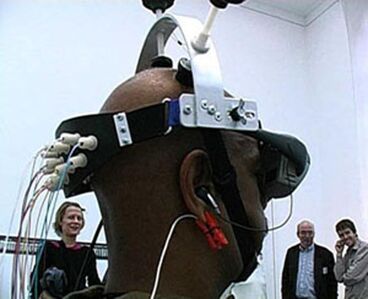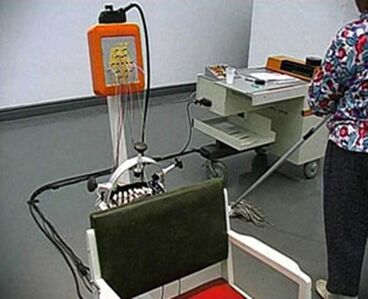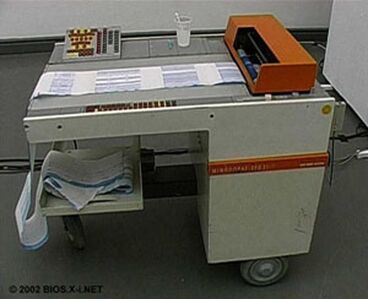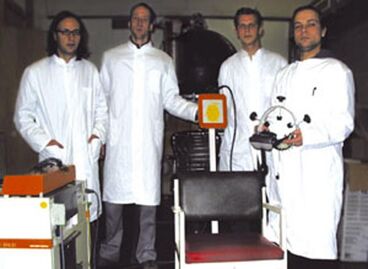Künstlerische Arbeiten Studierende


Autor/innen:
Betreuung:
Prof. Dr. Siegfried Zielinski
Martin Nawrath
Prof. Dr. Siegfried Zielinski
Martin Nawrath
Projektart: 2. Projekt
Eine Produktion der Kunsthochschule für Medien Köln
Links und Downloads
BIOS

Autor/innen:
Autor/innen: Autor/innen:
Entstehungsjahr: 2002
Kategorien: Installation, Installation, Videokunst, Videoskulptur
Kategorien: Installation, Installation, Videokunst, Videoskulptur
Projektart: 2. Projekt
In the course of history there have been many attempts to understand the way images are processed until finally they appear as ""impressions"" in the mind. Due to the lack of sufficiently sensitive sensors (and maybe also for pragmatic reasons), one of the first experiments involved showing a certain picture to a macaque monkey and subsequently shock-freezing the animal. After that, its brain was removed in what was hoped to be the state ""identical"" with the moment of discrete perception. Because the monkey was previously injected with a radioactive fluid, it was possible to produce an X-ray exposure showing a distorted version of the picture found in an area at the rear of the brain. Other perception-capture experiments were made by attaching invasive electrodes directly to the retina of a cat's eyes. The result was a very noisy black-and-white video; the resolution was very poor, but the origin remained clearly recognizable. These are just two examples of the ""normal"" methods still used by neurologists. We therefore did not want our apparatus to have the clean, highly polished appearance that commercial companies would prefer for their images. Instead, the visitor ought to receive some sensation of how one of the countless test monkeys might have felt before perishing in the course of the scientific quest to create the theoretical basis for our machine. However, we did not build our apparatus solely in order to protest against such experiments. It also has a deep connection to the old philosophical problem of reality, or more precisely, of distinguishing between what is ""real"" and what is ""hallucination."" Because the transformation of light energy into the language of the brain takes time, our seeing is always delayed. The visual and aural impulses emitted by a nearby object reach our brain at different times. Thus, due to the divergent temporal performance of our sensory organs, events that are objectively simultaneous are subjectively dislocated in time. Although these differences are very slight in terms of human perception, use of the term ""simultaneous"" is justified neither in the physiological nor quantum-mechanical sense. Everything that one sees, hears, smells and feels occurred prior to our perception of it. In other words: We ""scan"" reality in similar fashion to the frames of a film. A feeling of time is generated by the clocking of this scanning, by the density of registering modifications. It is very evident how dependent perception is on the biological condition of the perceiving creature. A cold lizard perceives time more slowly than does a warm one. In stressful situations, time seems to pass faster than when we are enjoying a peaceful rest. Besides the above problems, one runs into real, and not purely linguistic, difficulties when trying to decide if it would be possible to distinguish between a simulation of all senses (by some kind of machine not yet invented) and the ""real"" world. At the moment, we are remote from building such a machine, but we imagine that at least some of our readers have had dreams in which they touched, heard, saw or even smelled things as vividly if they were awake. One possibility of gaining a sense of what perceptional interpretation means would be to amplify it. In other words: If we found a way of tapping the perceived signal after its transformation, then it could be ""fed back"" in order to be transformed again, and this re-transformation would be repeated an undefined number of times and amplified in the process. Basically, that is what BIOS does. The Apparatus An exterior audiovisual perception path forming a closed loop with the natural path is generated. The viewer is invited to immerse himself in his own (physiological) perception. The attached electrodes transfer to an electroencephalograph (EEG) signals from the three sensory areas of the brain cortex, namely the visual cortex V1 along with the two auditive cortices. A custom-built interface translates the voltage curves of the EEG into binary data. Thus it is possible to algorithmically ""
Mitarbeit:
Norman Muller, Jaanis Garancs, Thomas Tirel, Sven Hahne Betreuung:
Prof. Dr. Siegfried Zielinski, Martin NawrathEine Produktion der Kunsthochschule für Medien Köln
Bitte warten













